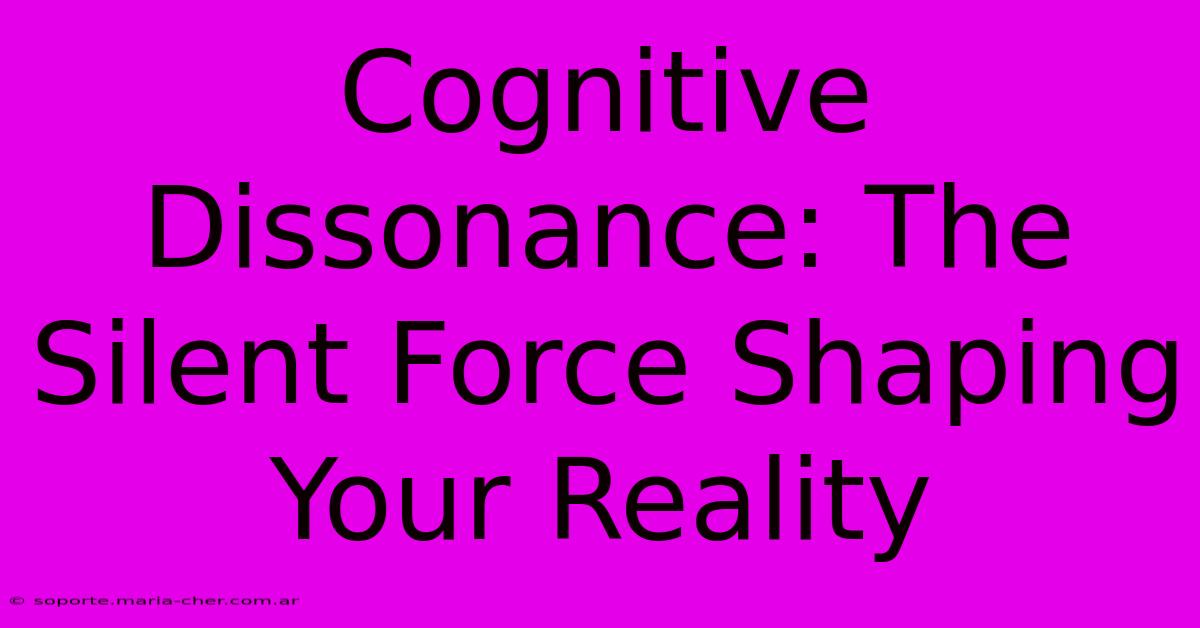Cognitive Dissonance: The Silent Force Shaping Your Reality

Table of Contents
Cognitive Dissonance: The Silent Force Shaping Your Reality
Cognitive dissonance. It's a term that might sound intimidating, but it's a powerful psychological concept that profoundly impacts our daily lives. Understanding cognitive dissonance can unlock insights into our decision-making processes, relationships, and even our beliefs about the world. This article delves into the core of cognitive dissonance, exploring its mechanisms, effects, and how to navigate its influence.
What is Cognitive Dissonance?
At its core, cognitive dissonance is the mental discomfort experienced by a person who holds two or more contradictory beliefs, ideas, or values. This discomfort arises when our actions clash with our beliefs, or when we hold two conflicting beliefs simultaneously. For example, you might believe smoking is harmful (belief 1) but continue to smoke (action/belief 2). This inconsistency creates a state of dissonance, an unpleasant feeling of tension.
Think of it like a mental tug-of-war. Your brain is wired to seek consistency and harmony. When faced with conflicting information or behaviors, it strives to restore balance. This drive to reduce dissonance is a fundamental aspect of human psychology.
How Cognitive Dissonance Manifests
Cognitive dissonance isn't always obvious. It often operates subtly, shaping our perceptions and behaviors in ways we may not even realize. Here are some common ways it manifests:
1. Rationalization: The Justification Game
When faced with dissonance, our minds often jump into overdrive to justify our actions or beliefs. We might downplay the negative aspects of our choices or exaggerate the positives. For instance, a smoker might rationalize their habit by saying, "Everyone dies of something, and I enjoy it." This justification helps reduce the discomfort of knowing they're engaging in a harmful behavior.
2. Selective Exposure: The Information Filter
We tend to seek out information that confirms our existing beliefs and avoid information that contradicts them. This selective exposure reinforces our current viewpoints and minimizes the potential for cognitive dissonance. For example, someone who believes climate change is a hoax might only read articles that support that belief and avoid scientific evidence to the contrary.
3. Change in Beliefs or Behaviors: The Course Correction
Sometimes, the discomfort of dissonance becomes too much, leading to a change in either our beliefs or our behaviors. This is a more constructive response to dissonance, involving a reevaluation of our actions or beliefs to align them more consistently. A smoker might decide to quit after witnessing the health consequences firsthand.
4. Minimizing the Importance: The Downplaying Technique
Another strategy is to reduce the perceived importance of the conflicting elements. For example, someone who cheated on a test might tell themselves it's "no big deal" to minimize the dissonance caused by violating their moral code.
The Impact of Cognitive Dissonance on Decision-Making
Cognitive dissonance plays a significant role in our decision-making processes. After making a choice, we often experience post-decision dissonance—the discomfort of realizing we might have made the wrong decision. To alleviate this discomfort, we tend to focus on the positive aspects of our choice and downplay the negative aspects of the alternatives we rejected. This helps us feel better about our decision, even if it wasn't the objectively best one.
Overcoming Cognitive Dissonance
While cognitive dissonance is a natural part of the human experience, understanding its mechanisms can empower us to make more informed choices and navigate challenging situations more effectively. Here are some strategies for managing dissonance constructively:
- Embrace self-awareness: Recognize when you're experiencing dissonance. Becoming aware of the tension is the first step towards resolving it.
- Seek diverse perspectives: Actively expose yourself to different viewpoints, even those that challenge your beliefs.
- Practice critical thinking: Analyze your beliefs and behaviors objectively, questioning assumptions and biases.
- Accept uncertainty: Recognize that not all questions have easy answers, and it's okay to hold conflicting or uncertain views.
Conclusion: Embracing the Dissonance
Cognitive dissonance, while often uncomfortable, is a natural and fundamental aspect of human psychology. By understanding its mechanisms and developing strategies for managing it constructively, we can gain a deeper understanding of our own thoughts, behaviors, and decision-making processes. Rather than fearing dissonance, we should learn to embrace it as an opportunity for growth and self-reflection. It's a silent force, but with awareness, we can harness its power for positive change.

Thank you for visiting our website wich cover about Cognitive Dissonance: The Silent Force Shaping Your Reality. We hope the information provided has been useful to you. Feel free to contact us if you have any questions or need further assistance. See you next time and dont miss to bookmark.
Featured Posts
-
Durability Demystified Vermeil Vs Gold Plated Which Stands The Test Of Time
Feb 07, 2025
-
Clickbait And Unique Titles For Cognitive Dissonance
Feb 07, 2025
-
Unicorn Rainbow Nation Unleash The Magic Of Oregons Cheer Signs For Lgbtq Pride Unicorn
Feb 07, 2025
-
Unveiling The Collation Process From Paper To Perfect Bound Books
Feb 07, 2025
-
Elevate Your Home Theater The Vga To Hdmi Adapter That Transforms Your Entertainment
Feb 07, 2025
